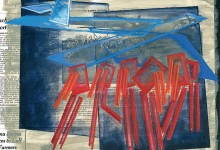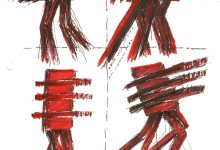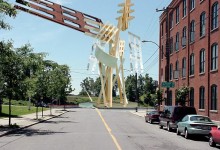Melvin Charney: Images troublantes d’un monde idéalisé
Text by Tatiana Mellema
For Melvin Charney the cities we inhabit are alive and well but they have morphed into vast regions while our grasp of urban phenomena is mired in cozy quartiers and driven by dated ideals of progress.
Charney’s work seeks to redefine some of the fundamental values that have marked every form of human settlement. He is one of Montréal’s most influential artists, responsible for a variety of the nation’s well-known public artworks including The Canadian Tribute to Human Rights, Ottawa (1986-90), The Canadian Centre for Architecture Garden in Montréal (1987-90) and Les Maisons de la rue Sherbrooke (1976) that was part of the infamous Corridart exhibition taken down by city officials on the day before the opening of Montréal’s 1976 Olympic games. Both nationally and internationally recognized, Charney’s work has been in numerous museum exhibitions including, briefly, P.S.1 New York, 1979; the Musée d’art contemporain de Montréal, 1979, 2003; the Museum of Contemporary Art, Chicago, 1982; Musée national d’art moderne, Centre Georges Pompidou, Paris, 1994. He represented Canada at the Venice Biennale on two occasions – the XLII Venice Biennale International Exhibition of Art,1986, and the VII Venice Biennale International Exhibition of Architecture, 2000.
Trained as an artist and architect, Charney takes the city as the subject of his work, in drawings, photographs, montages, paintings, sculptures, and site-specific constructions that play on the spaces, forms, and cultural representations of our urban structures. Central to his art has been his photo-based work UN DICTIONNAIRE… (1970-2001); four hundred and twenty six reproductions of newspaper images are organized to examine relationships between people and their changing urban environment. Using this archive as a thematic and visual source, Charney’s works layer and juxtapose images unearthing in this way larger social, political and economic structures that engender public and private space. Built structures that we normally take for granted as neutral are revealed as the product of an urban consciousness that citizens both register and generate.
Charney attempts to reveal human characteristics embedded in built form. In the series, ONE FIT SIZES ALL, he picks up on the total standardization and codification of the urban space. Charney sources includes the ubiquitous American skyscraper; or, for example, an overbearing façade of the Université de Montréal’s HEC (School of Business.) His preoccupation with wire-service photos published in the front pages of newspapers has recently given way to a concern with the back pages – the heady realm of sex-trade advertisements. The processes of the standardization of space is now applied to the human body, starting with critical components of reproduction and our potential for genetically modifying the size, shape and behavior of the human form so that it fits into the spaces that society is capable of generating. Iconographic constructs are fragmented; the size, shape and behavior of new urban creatures emerge from their fissures.
Charney isolates codes from the spatial patterns of our lives in order to examine ideals behind their production. Clusters of cities that still thrive in urban zone are alive in his work, its transformation carried out by the daily compliance of its citizens who become the agents of their own destruction. Charney’s works remind us that material objectivity does not exist, and that in fact our production of the city is rooted in the logic of power. As we codify our public and private space according to illusions of progress, we codify our own experiences of the human body. We may not look like walking skyscrapers, but the absurdity of Charney’s metaphor reveals itself as not so absurd after all.









